Proper posture is the most important element in establishing good ergonomic work practices. During repetitive tasks such as pipetting, maintaining body positions that provide a maximum of strength with the least amount of muscular stress is important to minimize the risk of injury. A number of common pipetting techniques have been identified as potentially hazardous due to biomechanical stress factors. Graphic representations and the recommendations for corrective actions, made by various US governmental agencies and ergonomics experts, are presented below.
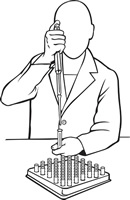 Technique: Elevated, “winged elbow”. The average human arm weighs approximately 6% of the total body weight. Holding a pipette with the elbow extended (winged elbow) in a static position places the weight of the arm onto the neck and shoulder muscles and reduces blood flow, thereby causing stress and fatigue. Muscle strength is also substantially reduced as arm flexion is increased.
Technique: Elevated, “winged elbow”. The average human arm weighs approximately 6% of the total body weight. Holding a pipette with the elbow extended (winged elbow) in a static position places the weight of the arm onto the neck and shoulder muscles and reduces blood flow, thereby causing stress and fatigue. Muscle strength is also substantially reduced as arm flexion is increased.
Corrective action: Position elbows as close to the body as possible, with arms and wrists extended in straight, neutral positions (handshake posture). Keep work items within easy reach to limit extension and elevation of arm. Arm/hand elevation should not exceed 12” from the worksurface.
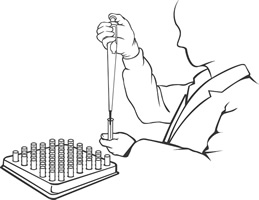 Technique: Over-rotated forearm and wrist. Rotation of the forearm in a supinated position (palm up) and/or wrist flexion increases the fluid pressure in the carpal tunnel. This increased pressure can result in compression of soft tissues like nerves, tendons and blood vessels, causing numbness in the thumb and fingers.
Technique: Over-rotated forearm and wrist. Rotation of the forearm in a supinated position (palm up) and/or wrist flexion increases the fluid pressure in the carpal tunnel. This increased pressure can result in compression of soft tissues like nerves, tendons and blood vessels, causing numbness in the thumb and fingers.
Corrective action: Forearm rotation angle near 45° pronation (palm down) should be maintained to minimize carpal tunnel pressure during repetitive activity.
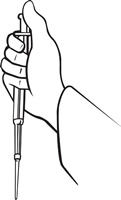 Technique: Tight grip (clenched fist). Hand fatigue results from continuous contact between a hard object and sensitive tissues. This occurs when a firm grip is needed to hold a pipette, such as when jamming on a tip, and results in diminished hand strength.
Technique: Tight grip (clenched fist). Hand fatigue results from continuous contact between a hard object and sensitive tissues. This occurs when a firm grip is needed to hold a pipette, such as when jamming on a tip, and results in diminished hand strength.
Corrective action: Use pipettes with hooks or other attributes that allow a relaxed grip and/or alleviate need to constantly grip the pipette. This will reduce tension in the arm, wrist and hand.
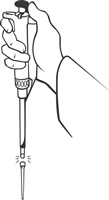 Technique: Concentrated area of force (contact stress between a hard object and sensitive tissues). Some devices have plungers and buttons with limited surface areas, requiring a great deal of force to be expended by the thumb or other finger in a concentrated area.
Technique: Concentrated area of force (contact stress between a hard object and sensitive tissues). Some devices have plungers and buttons with limited surface areas, requiring a great deal of force to be expended by the thumb or other finger in a concentrated area.
Corrective action: Use pipettes with large contoured or rounded plungers and buttons. This will disperse the pressure used to operate the pipette across the entire surface of the thumb or finger, reducing contact pressure to acceptable levels.
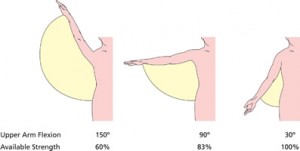 Incorrect posture can have a strong impact on available strength.
Incorrect posture can have a strong impact on available strength.
Technique: Elevated arm. Muscle strength is substantially reduced when arm flexion is increased.
Corrective action: Keep work items within easy reach to limit extension and elevation of arm. Arm/hand elevation should also not exceed 12” from the work-surface.
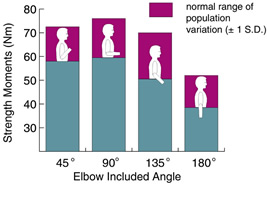 Technique: Elbow flexion or abduction. Arm strength diminishes as elbow posture is deviated from a 90° position.
Technique: Elbow flexion or abduction. Arm strength diminishes as elbow posture is deviated from a 90° position.
Corrective action: Keep forearm and hand elevation within 12” of the work-surface, which will allow the elbow to remain near a 90° position.
The Ovation Solution
The Ovation Pipette was specifically designed to address each of these posture-related concerns.
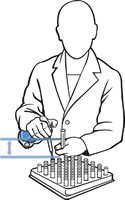
- The user’s arm elevation remains low, minimizing stress to the elbow, shoulder and neck.
- The user’s elbow remains close to the body in a neutral posture to maximize available arm strength.
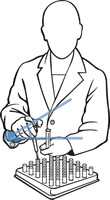
- The user’s wrist remains in a pronated position and neutral range of motion throughout all pipetting operations, eliminating repetitive twisting of the forearm and reducing pressure on the carpal tunnel.
- Ovation’s adjustable hook allows a custom fit and reduced holding effort for right and left-handed users.
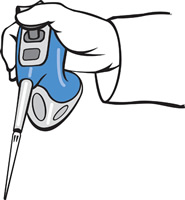
- The pipette’s contoured shape provides maximum stability and minimal contact pressure for the hand. A loose, relaxed grip increases available strength in the hand, improving endurance and productivity during pipetting.
- Ovation features such as a rounded plunger button and a tip ejection button have reduced forces that minimize contact stress.
Find more articles about Ovation Pipettes
